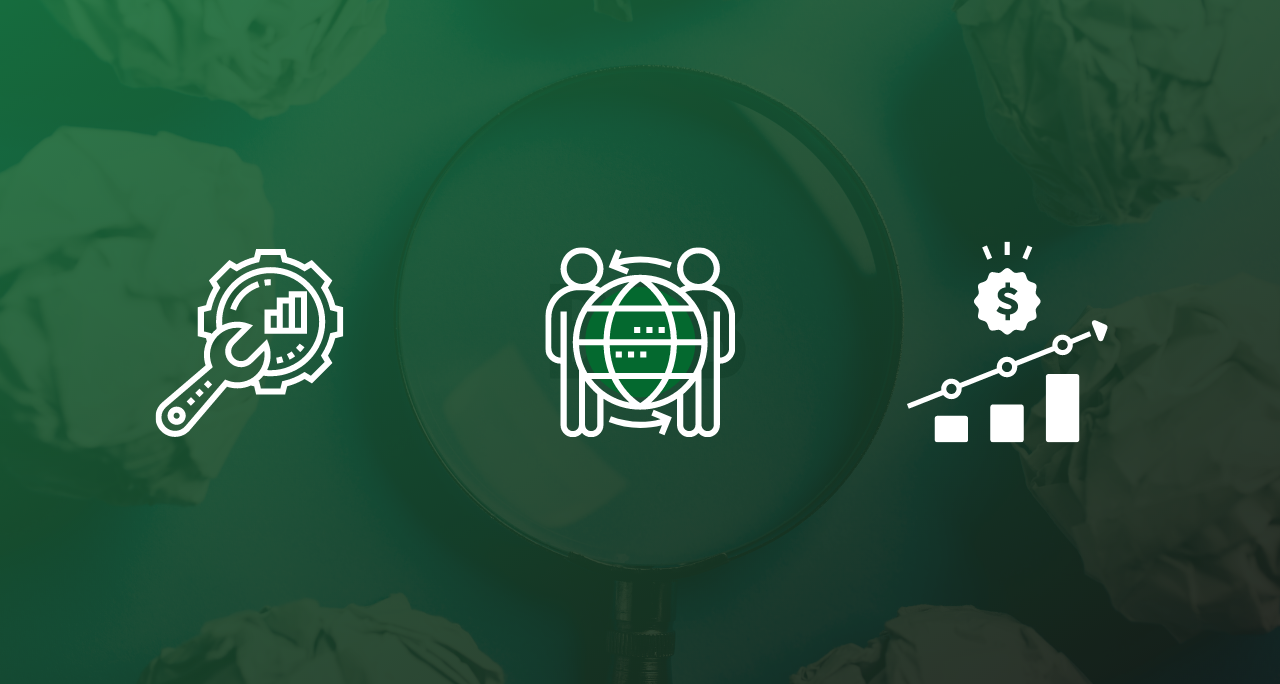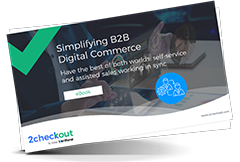In 2021, B2B software customers don’t need to and don’t want to talk to your sales team just to learn about your company and products or to compare pricing or features. They can access all of this information online, read reviews of your business and product(s), and complete much of their buying journey on their own. With try-before-you-buy models becoming the norm in many sub-verticals, these modern buyers are no longer dependent on you to make a sales decision.
It wasn’t always this way, of course. Nearly a century ago, an American named Dale Carnegie formulated what we know as the modern sales model. Carnegie’s linear funnel model for selling provided businesses a framework to manage the customer journey. In this model, the business was in almost complete control of the information surrounding their product and the course of the sale. Their customers accepted that; they didn’t have a choice.
For decades this model thrived. Then came the internet, and an explosion of technology and online content that shifted the power in the B2B buyer/seller relationship. Customers discovered the tools to gain more control over how they decided what to buy, and from whom.
B2B software companies, and the modern buyer
The selling trajectory for software companies has also changed in the last several years. Whereas before the focus was on developing direct sales forces that chased down impressive, sizable deals, usually purchased by the buyers’ IT department and then carefully monitored by the procurement department, the process has shifted.
Today, buyers compare multiple providers and spend only a tiny fraction of their buying journey with a sales rep; research from Gartner has revealed that B2B buyers considering a purchase only spend 17% or less of that time meeting with potential suppliers.
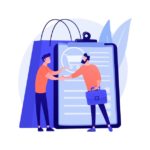
To begin to tackle the intricacies of this new buying journey and thrive in the transformed sales environment post-digital age, it’s more important than ever for software businesses to understand today’s B2B buyer profiles and their buying journey.
The modern B2B buyer has a fairly distinctive profile:
- Demographically and geographically diverse, predominantly made up of millennials (!)
- Grew up in the digital era and are comfortable doing online research via multiple digital channels
- Still want the option of high-touch customer service at some point in their buying journey; they expect a customized experience adapted to their specific needs and goals
- Driven by practical factors while making purchase decisions – such as the minimum cost and functional value of the acquisition for the company – but also taking into account emotional factors, as individuals
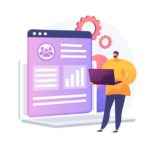
- Make decisions as part of a team, with different stakeholders in different roles, but also have their individual preferences
- Primarily channel-agnostic but very focused on mobile (80% of buyers use mobile phones throughout their B2B buyer’s journey.)) and certainly looking for a consistent brand experience from your business; they expect seamless, responsive, easy service across all channels.
- Favor online purchases, giving greater emphasis to digital commerce. The total share of B2B sales made through an eCommerce site is expected to reach $1.8 trillion and account for 17% of all B2B sales in the US by 2023. 76% of B2B buyers said the website design of an eCommerce store is the most important factor influencing their buying decision.
The 4 key differences between the B2B and B2C buyer journey
- With B2B, you’re selling to a team; with B2C, you’re selling to individuals. The B2B buyer journey is complicated by the fact that there are usually more individuals involved – one study showed that almost 80% of B2B buyers had from one to six people involved in the purchase process, with the rest 20% claiming a team of seven or more. This can make the process considerably longer and more arduous.
- B2B deal sizes are usually larger. B2B transactions are usually bigger than with B2C, both in order amounts and total revenue per customer, making more money per sale. This means your business can be more strategic and particular about leads than B2C, who need a more scattershot approach to gather a greater number of leads.
- It takes longer to close a sale with B2B than with B2C. Getting decision-makers on board a B2B sale is likely to take longer – between a few weeks and nine months on average for larger deals – and be more effortful, requiring more thought and research on the part of the buyer than with a typically more impulsive B2C purchase.
- B2B customers are emotionally involved in their purchase, too. Once the functional value, performance, economic, ease of doing business, etc. criteria are met, individual values weigh in the decision. After all, individuals make the purchase decision, even if that decision is made as a team. Overall, it’s more about finding the right vendor/partner “fit” than who offers the biggest business-related value.
Why understanding the buyer journey is important
Tech buyers expect more and are more agile, and they are making purchase choices that directly correlate to the needs of their business. Deal sizes are decreasing, with buyers reluctant to commit to huge upfront commitments. Software subscriptions are on the rise. There has been an explosion of application choices and buyers expect to be able to try products before committing, and they also expect deep customization options.
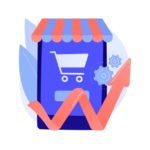
Research by Gartner has shown that in this new era of buyer access to online decision-driving content, over 70% of their B2B buying process has already been done before they even contact a salesperson. This independence means businesses need to create additional interactions through touchpoints at each stage of their journey. Let’s take a closer look at these stages.
The 4 stages of the B2B buyer journey
1. The Awareness and Discovery Stage
This is the point of inspiration and education. This is where you create top-of-mind recognition, and ideally – even influence need identification.
2. The Consideration and Evaluation Stage
This is the investigation stage, where it’s essential to provide the answers to your prospects at every turn in their online research. There are many ways to do this, including:
- Making your online educational content easy to find
- Participating in online and/or in-person industry events (as allowed during the pandemic)
- Getting featured in industry reports and publishing benchmarks
- Using social channels for exposure
- Asking existing clients for reviews on third-party review platforms
- Building a referral program
- Offering solution comparisons
With 61% of B2B buyers saying they trust the judgment of their colleagues, other users, and reviews when researching for a tech purchase, it’s an area you need to pay attention to. Your potential customers will be comparing your company to competitors, and it’s at this stage that they may first reach out to your sales reps, so be ready to answer their questions and concerns, clarify and offer product demos, and tell them about other personalized services.
3. The Decision Stage
Your potential customer has completed their research and is ready to commit to a purchase. However, as the B2B sales cycle is considerably longer than with B2C, it could be up to 3 to 9 months before this stage is reached, composed of in-depth research, discussion, trial options, decision making, and approval process by your customer’s team.
With 77% of B2B buyers saying the last purchase they made was complicated, your aim is to simplify the buying process. One way to do this is through a hybrid sales approach, with one-on-one interaction with a sales rep – assisted sales – working not on its own, but in sync to the increasingly important online self-service.
4. The Loyalty Stage
The B2B decision stage is not the conclusion of the buyer’s journey—now that they’ve made a purchase, the review process of how well your product and services suit them begins. This is the time to nurture these clients so they will be delighted with their decision.
If this stage is carried out carefully, your customers will be more likely to recommend you to others and provide positive reviews and recommendations about your product and your company.
Regardless of the stage, an important aspect is to determine which content will provide the most value. Where they are in their journey and how they found you will help determine what content to share, and when, and how to keep your sales team one step ahead of any concerns, questions, or issues your potential customers may have, to guide them to the next stage in their journey. This content might be case studies, testimonials, or other helpful content.
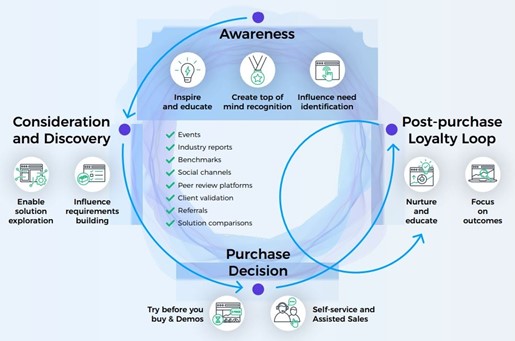
How defining the B2B buyer journey can impact your bottom line
1. It will enable you to formulate an effective growth strategy. Understanding your customers and their journey will make it easy to know what content, and on what channels, will reach them in the most optimally.
2. It will make the jobs of your sales and marketing teams seamless and successful. Knowing what your potential customers expect at each stage of their buying journey helps clarify how to best move them along the path until they become customers.
The bottom line: understanding the buyer journey and aligning your sales process to it will improve the buyer experience, helping them move quickly through the sales funnel. The long-term results? Higher revenues, customer loyalty, and word-of-mouth brand recognition. Understanding the B2B buyer’s journey is essential to maximize the success of your business and its future.
For a more detailed look at how B2B buyer journeys are evolving, and how you can meet these changing needs through a strong digital commerce solution, download a copy of our eBook.

